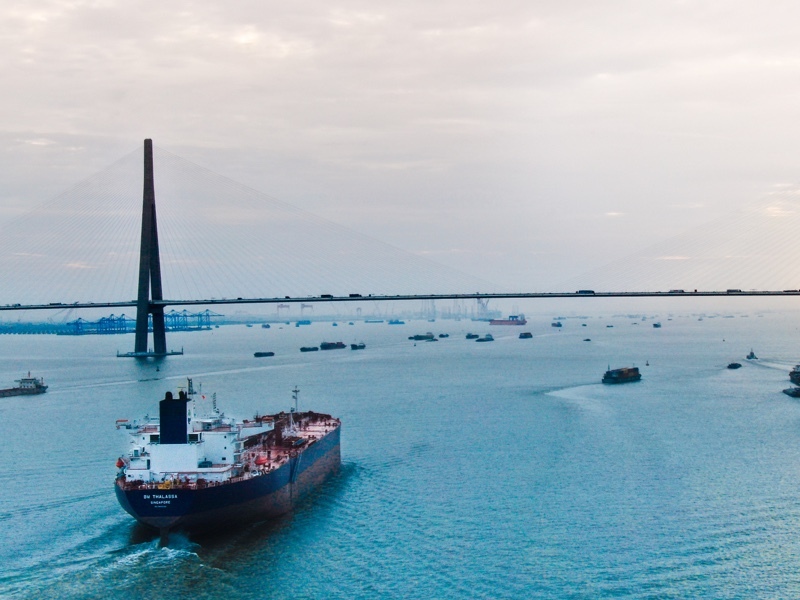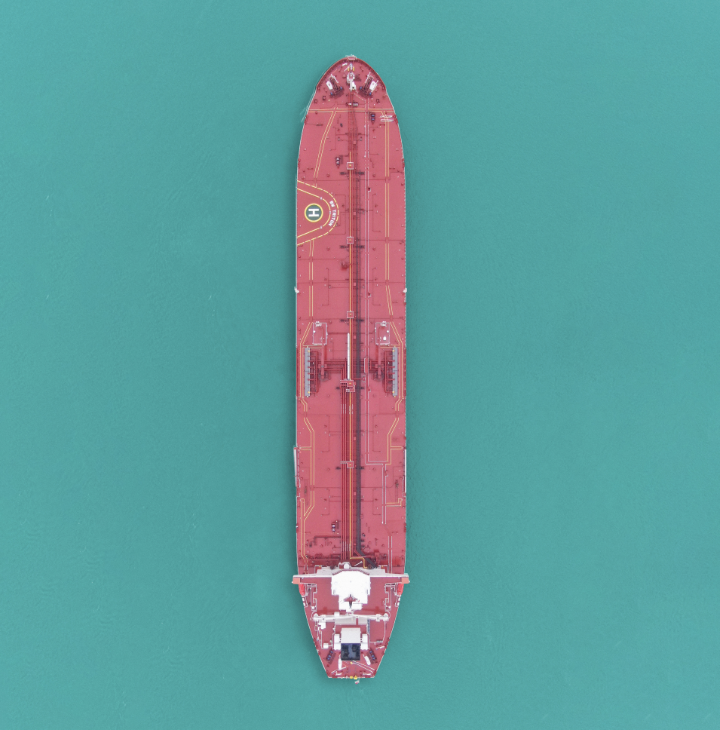06 | Environmental Impact
Greenhouse gas emissions and air quality
Our sustainability journey starts with decarbonisation, both within our own operations and across the shipping industry as a whole. Since 2020, Hafnia is a committed member of the “Getting to Zero Coalition”. Together with members across the entire maritime value chain, we participate in working group sessions on the topics of developing a “transition strategy for shipping decarbonisation”, “accelerating shipping decarbonisation through policy action” and calling on governments to support this transition through policy and market measures. Hafnia’s efforts around greenhouse gas emissions are focused on three key areas:
- Compliance with the IMO’s 2030 decarbonisation targets
- Vessel optimisation initiatives
- Low emissions vessels

| Fleet emissions and efficiency metrics | Unit | 2019 | 2020 | 2021 |
| Number of vessels included in emission computation for the year | 89 | 89 | 88 | |
| Fuel use and resulting emissions | ||||
| HSHFO | Metric ton | 383,202 | 20,451 | 20,058 |
| VLSFO | Metric ton | 24,066 | 362,816 | 356,294 |
| LSMGO | Metric ton | 81,128 | 86,652 | 86,312 |
| CO₂ | Metric ton | 1,529,223 | 1,484,724 | 1,461,858 |
| NOx | Metric ton | 79,586 | 77,724 | 76,528 |
| SOx | Metric ton | 21,095 | 4,906 | 4,819 |
| Distance sailed in nautical mile | NM | 4,594,384 | 4,549,692 | 4,711,327 |
| CO2 emission in grams per ton-nautical mile (Based on capacity work) (AER) | gms/T NM | 5.83 | 5.70 | 5.40 |
| Black Carbon | Metric ton | 91.85 | 86.60 | 85.51 |
Please note: For SOx calculation (S%), average 2.7% S for HSHFO, 0.5% S for VLSFO & 0.1% S for LSMGO is used. For NOx calculation, 14.4 g/kwh is used. Kwh is coputed from Specific energy. HFO: 40.400 MJ/Kg, LSHFO: 41.200 MJ/Kg, MGO: 42.200 MJ/Kg was used. Black Carbon calculation is based on Table 63 and Table 64 of MEPC 75/7/15
Decarbonisation
Hafnia is committed to the IMO’s Carbon Intensity Targets, including its regulations on sulphur emissions and 2030 goals to reduce carbon intensity by 40% and 2050 goal to reduce total GHG emissions by 50% against a 2008 baseline.
We are working hard to reduce our current fleet’s carbon intensity to 4.35 gms/T NM by 2028, meeting the IMO’s 2030 targets ahead of schedule. In 2021, Hafnia’s carbon intensity as measured by the Annual Efficiency Ratio (AER) was 5.40gms/T NM, 6.40% better than the present IMO baseline.
Vessel optimisation
In 2021, Hafnia’s owned vessels sailed 161,634 nautical miles more than 2020. Despite this they consumed 7,256 MT less fuel and emitted 22,866.8 MT less CO2, with the Energy Efficiency Operational Index (EEOI) improving by 2% compared to 2020.
Hafnia’s Status with IMO’s Carbon Intensity Targets – Existing Fleet

Energy Saving Initiatives on Hafnia Vessels
Hafnia has implemented numerous energy saving initiatives which have resulted in overall fuel savings and improved efficiency:
CO2 emissions and energy efficiency
| 2019 | 2020 | 2021 | |
| Total Transport work (T-NM) | 127,613,527,513 | 141,530,725,954 | 136,834,276,165 |
| Distance sailed (NM) | 4,594,384 | 4,549,692 | 4,711,326 |
| Fuel consumed (MT) | 488,396 | 469,919 | 462,663 |
| CO₂ Emission (MT) | 1,529,223 | 1,484,724 | 1,461,858 |
| Energy efficiency operational index (gms C02/TNM) (EEOI) | 11.80 | 10.90 | 10.68 |
SMARTShip – Cloud-based solution that collects live data from vessels and provides both office staff and ship staff with real-time analytics and insights of the vessel’s performance to increase operational efficiency. Its user-friendly applications help in faster decision making in day-to-day operations.
Hull coatings (self-polishing type) – Hull coating which is designed to polish off smoothly while maintaining a bioactive interface between the coating and water.
Hull coatings (foul release type) – Silicon based coating with controlled release of biocide. Keeps fouling at bay when vessel is underway and also during long idle periods due to biocide release. Low hull roughness equates to better fuel performance.
Propeller Boss Cap Fin (PBCF) – PBCF is made of the same material as the propeller and installed at its rear, breaking the hub vortex that forms behind the propeller to improve propeller efficiency.
Mewis duct – Cylindrical ducts fitted ahead of the propeller change the inflow angle and speed of water to the propeller, thereby improving propulsion efficiency.
Light Emitting Diode lights (LED) – Replacement of traditional lightning to LED lights with lower energy consumption and maintenance costs.
Kyma performance monitoring systems – is a sophisticated solution for overall vessel performance monitoring. This system integrates the Kyma Power Meter system with advanced Windows based PC software that continuously monitors performance data.
Variable frequency drives (VFD) – VFDs save energy and improve system efficiency by enabling electric motors to operate at various speeds. Hafnia uses VFDs on engine room vent fans, sea water pumps, scrubber pumps and steering gear motors.
Grey wing – A digital platform that integrates across crewing platforms, commercial software, travel providers, port agents, port restrictions, etc. to provide a single source for crew managers to make informed decisions on crew changes especially during Covid-19 times. This has reduced our carbon footprint due to optimised flights for the crew.
Derated engines – The new vessels have derated engines which ensures that the vessels achieve better fuel efficiency and improved performance.
Auto-tuning – PMI Autotuning system automatically adjusts the pressure in the combustion chambers of an engine’s cylinders for optimal running. This contributes to fuel saving and improved safety.
Air lubrication – A layer of air bubbles distributed on the flat bottom of the vessel to reduce the friction when moving through the water and thereby reducing the fuel consumption. We are investigating the possibility of fitting it for testing on a Hafnia vessel soon. Distributing equipment is installed on the hull and the air is lead in piping through penetrations in the hull to the distributors. The pressurized air is produced in dedicated air compressors installed in the engine room.
Our vessel optimisation measures are an integral part of our efforts to improve air quality by minimising the emissions into air. We regularly monitor and optimise our voyages, implementing corrective measures to improve underperforming vessels.

Low emissions vessels
As part of our commitment to innovation, Hafnia is continually exploring alternative, more efficient ways of conducting its operations. In 2020 and 2021, Hafnia ordered four Aframax LR2 tankers, equipped with liquefied natural gas (LNG) propulsion technology, due for delivery in 2023.
Adopting LNG as a fuel is an example of Hafnia’s strategic alliances with its customers and our genuine ambition to transition towards a greener future. LNG is widely regarded as a promising marine fuel to help the shipping industry transition towards its goal of a 50% reduction in GHG emissions by 2050. Switching to LNG as a fuel provides significant benefits, improving overall air quality and reducing GHG emissions. LNG fuelled vessel emit negligible SOx and particulate matter (PM equal to black carbon). LNG propulsion also reduces NOx emissions by up to 85% and GHG emissions by up to 23%. The GHG emissions of these vessels will be 5,000 tonnes per year lower than conventional tankers. Additionally, their design is such that they already meet Phase 3 Energy Efficiency Design Index (EEDI) requirements and will be compatible with multiple fuel types, including the zero emissions fuels of the future. Hafnia has also partnered with Arq to accredit and introduce Arq Fuel as a key blend component for marine fuels. Arq has developed a novel and patented technology that transforms environmentally damaging coal waste into a micro-fine hydrocarbon powder (Arq Fuel). After securing the required accreditations, trials scheduled for mid-2022 aim to confirm Arq Fuel’s compatibility for the approximately 450 vessels for which Hafnia procures fuels.